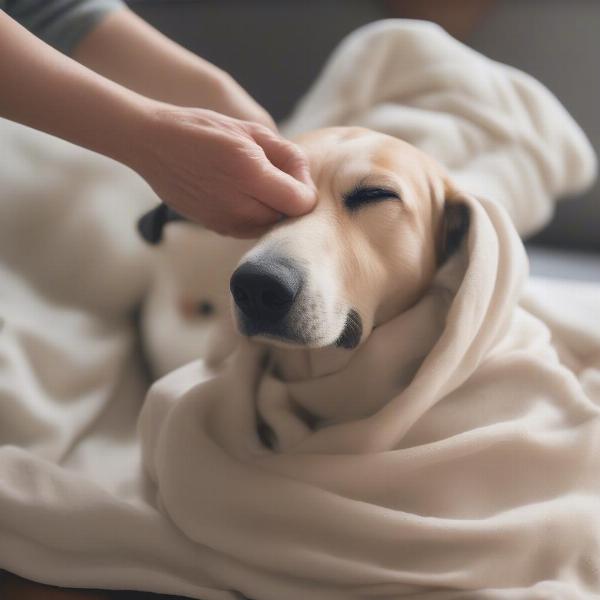A stye in a dog’s eye can be alarming for any pet owner. Recognizing a stye and understanding its causes is the first step in ensuring your furry friend receives the appropriate care. This article will provide valuable insights into identifying styes in dogs, exploring their causes, and outlining appropriate treatment options. We will also cover preventative measures to help safeguard your dog’s eye health. So, if you’re searching for “pictures of a stye in a dog’s eye” to help diagnose your pet’s condition, you’ve come to the right place.
A dog stye, medically known as a hordeolum, is a small, red, painful lump that develops on the eyelid. It often resembles a pimple. Styes occur when bacteria infect the glands around the eyelashes. While generally not serious, they can cause discomfort and should be treated promptly to prevent complications. Searching for pictures can help confirm your suspicion, but it’s crucial to understand the underlying causes and appropriate treatment.
Understanding Canine Styes: Causes and Symptoms
Several factors can contribute to the development of styes in dogs. Poor hygiene around the eyes, allergies, and underlying health conditions can all play a role. Symptoms include redness, swelling, and tenderness of the eyelid. Your dog might also squint or paw at the affected eye.
Recognizing the symptoms early is key to effective treatment. While pictures of a stye in a dog’s eye can be helpful for comparison, it’s always best to consult a veterinarian for a proper diagnosis.
Treating a Stye in Your Dog’s Eye
Most canine styes can be treated at home with warm compresses. Applying a clean, warm compress to the affected eye several times a day can help the stye drain naturally. Never attempt to squeeze or lance the stye yourself, as this can worsen the infection.
 Applying a Warm Compress to a Dog's Eye
Applying a Warm Compress to a Dog's Eye
In some cases, your veterinarian may prescribe antibiotic ointment or eye drops to clear the infection. It’s crucial to follow your veterinarian’s instructions carefully and complete the full course of medication, even if the stye appears to have resolved.
Preventing Styes in Dogs
Maintaining good hygiene around your dog’s eyes is crucial for preventing styes. Regularly cleaning the area with a pet-safe eye wipe can help remove debris and bacteria that can contribute to infections.
A healthy immune system also plays a vital role in preventing infections. Ensure your dog receives a balanced diet and appropriate vaccinations to support their overall health.
Conclusion
Recognizing a stye in your dog’s eye and understanding the causes and treatment options are crucial for responsible pet ownership. While “pictures of a stye in a dog’s eye” can be helpful for initial identification, always consult with your veterinarian for a definitive diagnosis and treatment plan. By following preventative measures and seeking prompt veterinary care, you can help ensure your dog’s eyes stay healthy and comfortable.
FAQ
-
What does a stye in a dog’s eye look like? A stye typically appears as a small, red, swollen bump on the eyelid, often resembling a pimple.
-
Are styes painful for dogs? Yes, styes can be painful and cause discomfort.
-
How are styes in dogs treated? Warm compresses are the primary treatment, but your vet may prescribe antibiotics in some cases.
-
Can I squeeze my dog’s stye? No, never squeeze a stye. This can worsen the infection and spread bacteria.
-
How can I prevent styes in my dog? Maintain good eye hygiene and ensure your dog has a healthy immune system.
-
When should I take my dog to the vet for a stye? If the stye doesn’t improve with warm compresses, or if your dog seems to be in significant pain, consult your veterinarian.
-
Are styes contagious? Generally, styes are not contagious between dogs or from dogs to humans.
ILM Dog is a leading international dog website dedicated to providing expert advice on all aspects of dog care and wellbeing. From breed selection and health to training, nutrition, grooming, and accessories, we’re your one-stop resource for all things dog-related. We offer valuable insights and practical tips for dog owners of all experience levels. For expert advice and personalized support, contact us today! Email: [email protected] Phone: +44 20-3965-8624 Visit ILM Dog for more information.